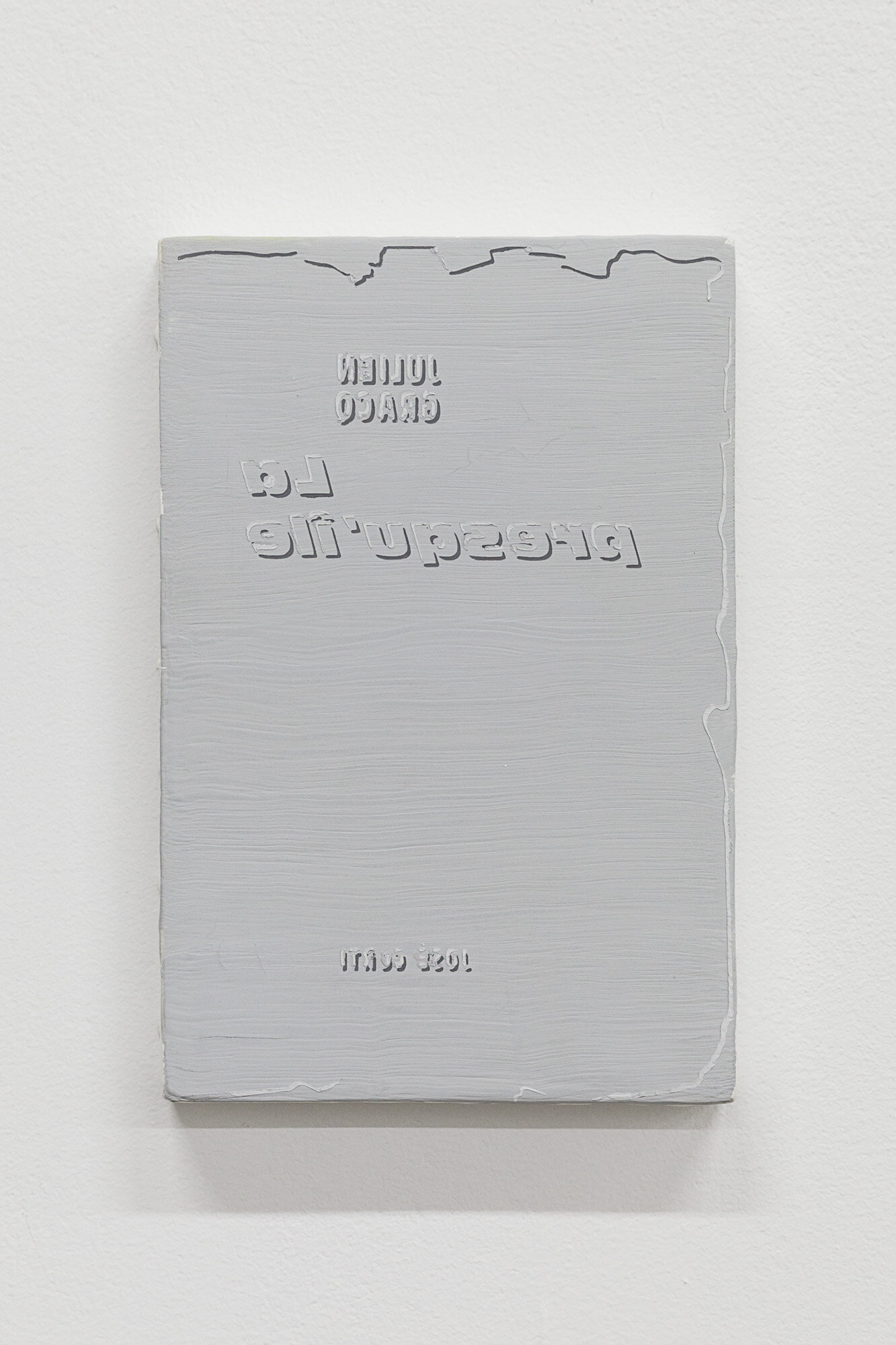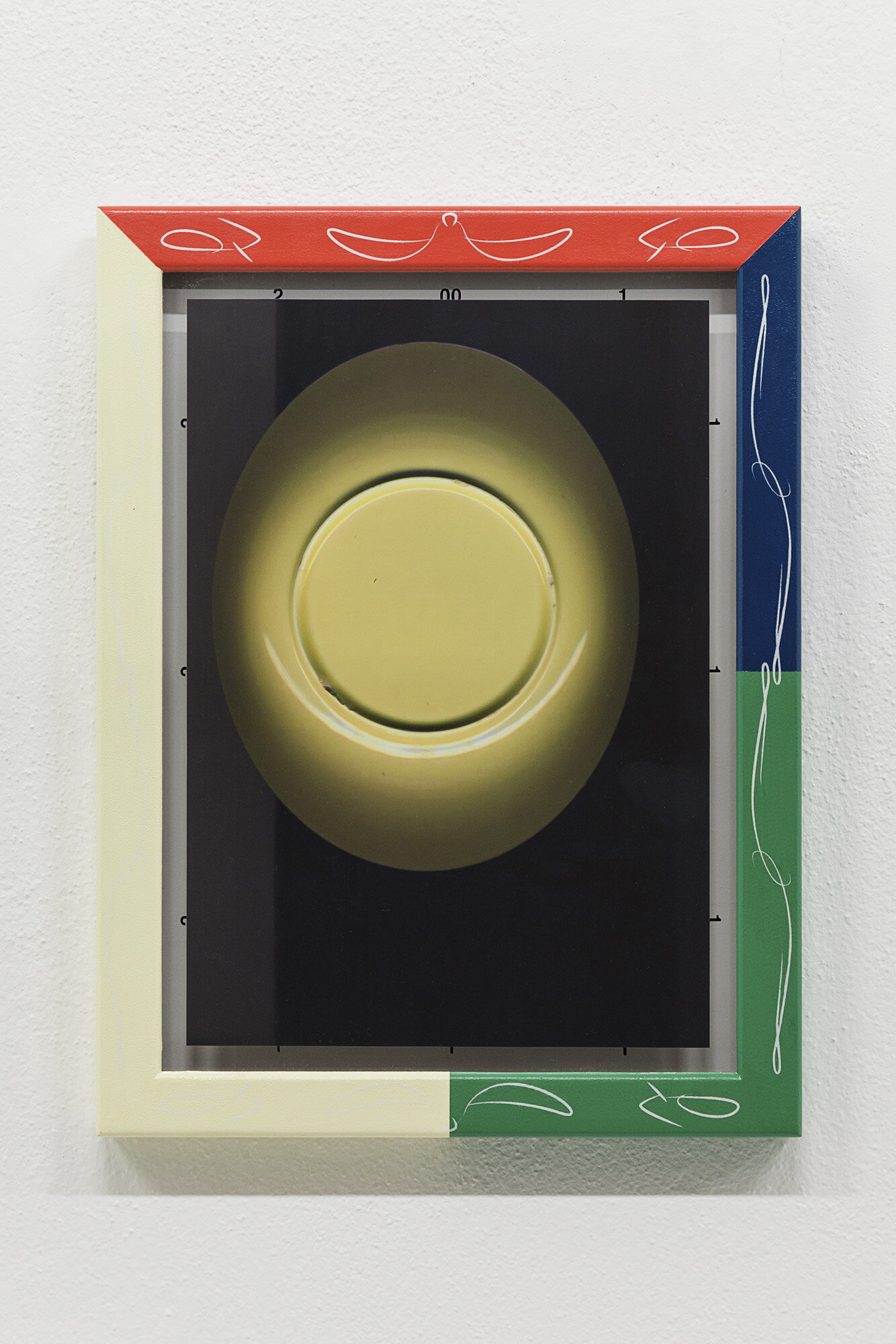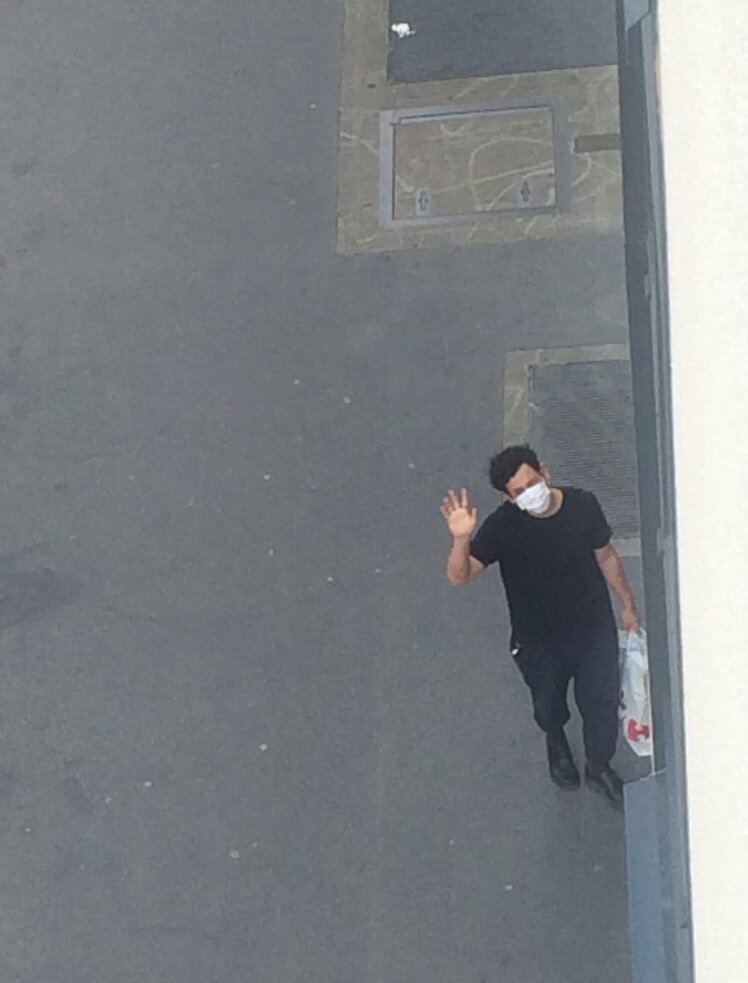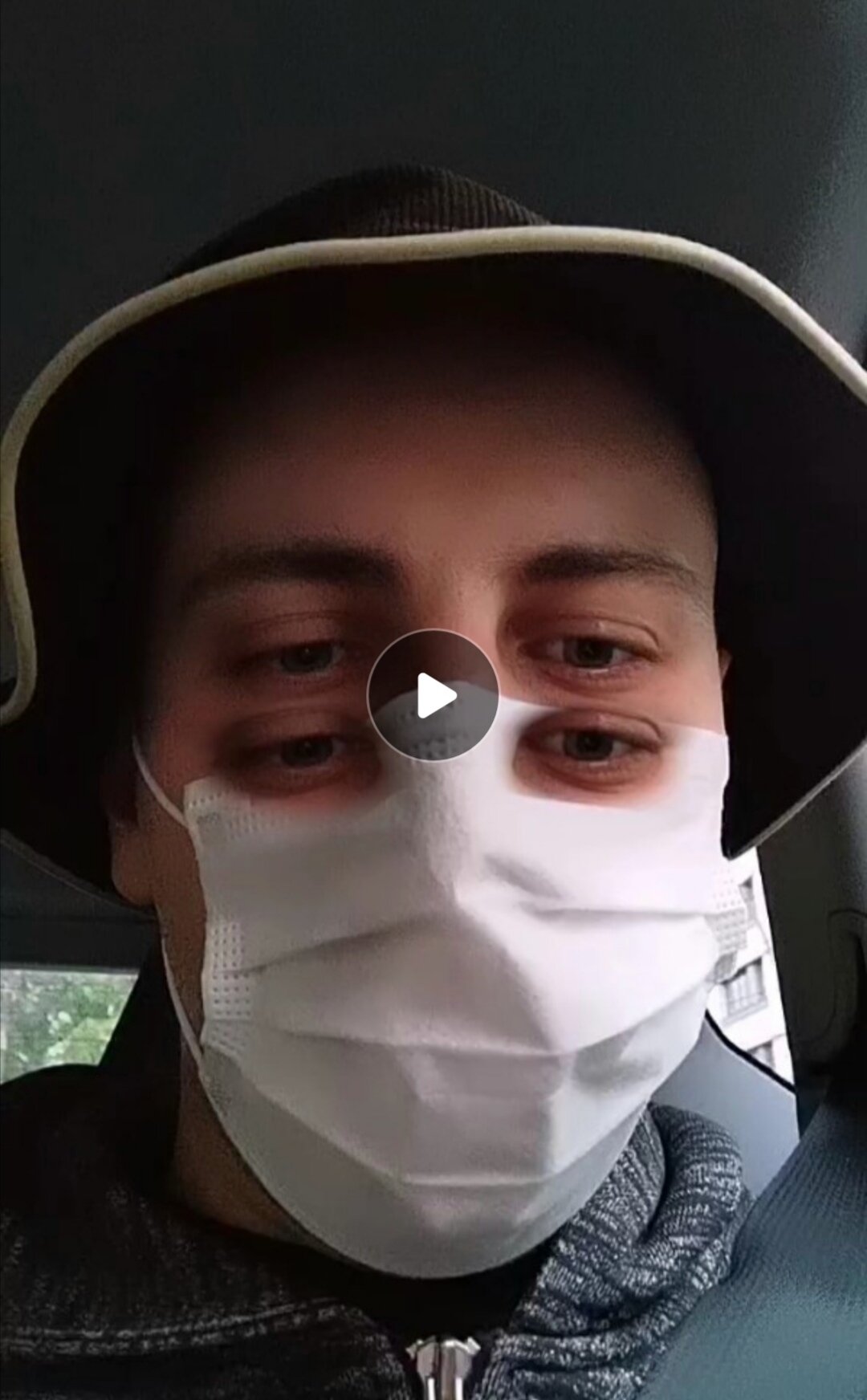(EN) Tristan Deschamps from +DEDE in conversation with Grichka Commaret and Guilhem Monceaux
Peach SCORE at DEDE + Courtesy of the artists and +DEDE, Berlin. Image: Nikolai Schlapps.
At VUNU’s, we’ve planned 2020 to be the year of international collaboration. After months of debates, the project Alterum involving Műtő Group from Budapest, 35M2 from Prague and U10 from Belgrade was born and now it operates online, but honestly. Let’s face it - it’s not the same. Another such thrilling collaboration was planned with +DEDE, a gallery based in Berlin. Our still at that time face2face meetings showed a lot of mutual understanding, shared visions and taste of arts, hence the reality of current days hit this upcoming and inspiring partnership hard. Yet, we’ve stayed in touch and now we invite you to read an interview with those lovely folks. Tristan Deschamps, co-founder of +DEDE interviews Guilhem Monceaux, a curator and Grichka Commaret, a painter.
Tristan Deschamps
Where are you guys confined?
Grichka Commaret I'm in my apartment with my girlfriend, in Paris near Montparnasse. We've moved what little furniture we have, rearranged our living space, to feel like we're somewhere else, probably in anticipation of the weariness that comes with being in the same place all the time.
Guilhem Monceaux I am also staying in Paris in my apartment with my girlfriend. I live in front of train tracks ☺.
TD France was especially hit by the pandemic, resulting in strict confinement measures. What have you planned on doing once the confinement is lifted on May 11th?
GC I haven't planned much. I got used to not projecting myself, to planning for the short term. Right now I'm concentrating on much more everyday things. It's been a real learning experience for me, as I find it hard to stay at home. After the 11th I will go to see my family, I will have a drink with friends and try to prolong this state to live a little bit with them.
GM It will feel good to go outside without having to show a piece of paper like we are children. Since you mention France, our country has shown remarkable coercive skills this last decade. This is the worst thing that has been in my mind this whole time: the way this pandemic is going to allow our government to dive deeper into repression. Any kind of terrorist virus can do the trick for the next crisis… In a broader sense, European political leadership looks like a very bad joke. The present already seems impossible to manage – this country steals masks from this one, borders are closing in a heartbeat… – so I’m not optimistic about long-term institutional organization. On a lighter note, I am currently fantasizing about creative ways to navigate new restrictive public policies. I am fascinated by masks that can trick facial recognition systems. I am trying to look into artworks that are tackling this subject, such as Hito Steyerl’s and Zach Blas’s larger than art initiatives-
Grichka Commaret, sans titre, 2017, 12 x 18 cm, Grichka Commaret, Bellini, 2017, 26 x 31 cm
TD You had a show planned with us, at +DEDE, and the timing of COVID-19 stopped us from opening the exhibition. And as we are slowly seeing the light at the end of this tunnel, I am really looking forward to putting this together. Can you please tell me more about the thoughts and the process behind La ville a des yeux ? (La Ville a des yeux is the title of Grichka Commaret's solo show at +DEDE)
GM To me, this exhibition is part of a long-term conversation that we are having with Grichka since we met in January last year. It was a pleasant meeting that we had at Villa Belleville in Paris where he was in residency, which turned into a friendship. We worked together with him and Anna Solal to organize an exhibition the following summer that also allowed us to publish a small book. The whole project, Presque tout, was an attempt to talk about art production from a precarious perspective. How do you collaborate, under which terms, and how do you make this terms the most transparent to fellow artists. Knowing that a lot of artists and curators don’t have money, how is it still possible to create autonomously with others? A lot of platforms emerged recently to reveal some nasty ways in which institutions treat artists. But I think there is a lack of analysis regarding the scales and specific situations of art spaces. Obviously, big mastodons have no excuse and are the most criticized, but artists or curators run initiatives are not all in the same boat. I hope the book we did, which was a critical extension of the show, was able to address this issue. Though I am not convinced it is the most efficient tool (art, books, etc…) because the audience is limited, I still think it is crucial to multiply perspectives on this matter. Regarding the show we are preparing at +DEDE: it makes sense to us – and we are glad that +DEDE agreed to collaborate with us – to be able to organize an exhibition of Grichka’s paintings in a structure such as those described above (not the mastodon ☺). Grichka can probably articulate this better than I do, but for this solo presentation, he will show new and old works that can give a good introduction to his work in Berlin. He is connecting intimacy and urbanism in a unique way through beautiful surrealist compositions. When you look at his part-airbrush part-something else paintings, you get sucked into the blurred lines that separate personal life and city obligations. It is also talking about how the aspirations of a child are transformed through adult life. And you can read this either as a child or an adult, no derogatory certificate required.
GCI just finished an exhibition at Pauline Perplexe, a run-space in the Paris suburbs. These last few weeks have allowed me to take some distance from this proposition. The format is quite similar to +DEDE's and I wanted to link these two moments. « Rouge Captif » was an introduction which by its rather disparate nature opened up several avenues, and if you look at it a little bit, it represents for me a "crossroads". The exhibition in Berlin will allow me to develop one of its aspects more precisely.For the moment it is still a night bus trip, the windows of the buildings along the road are lit, you can see the interiors in the distance. But a bit like in Guilhem's text, I would like the neighborhood we are passing through to address the spectator. I thought of paintings crossed by text, which could look like a series of advertisements that miss their targets...I don't have all the keys to describe the exhibition precisely yet, but ideally I would like some forms to be revealed in two stages. I remembered those cards I collected in primary school, they were very sophisticated objects that often mixed several types of impressions, some of them hid one image under the other (from DBZ to Naruto). There was a great excitement when they were discovered.My paintings naturally tend towards the memory of these objects, of course I give some ground, and all this is mixed with other less obvious things. I've been looking at Joseph Stella's paintings quite a bit recently. He is a painter linked to the DADA movement, his paintings are not excellent but I had the feeling that a reproduction of one of them could go along well with this bus. All this remains intuitive, but at the moment I feel like confronting some of the paintings I have seen in the books I like and my paintings that would become receptacles for these images.
TD Have you been able to work during the crisis?
GCI have had a few moments of introspection that have allowed me to unravel some of the images that were floating in my head. But I think when you've been living on the same day for two months it's hard to surprise yourself.We have more time, but I find it harder to use it, the days lack tension.
GMI agree, it gets very slow. I work as a freelance, which sucks most of the times, but I’m lucky I was still able to continue my low-income jobs at the distance. I know it’s not the case for everyone. Regarding my curatorial work, I can’t say I can work like this. Looking at our collaboration with Grichka, what is most important on my end is that we can meet and chat. I know that his paintings are the result of a painstakingly long process and I’m glad when we can share about it together, next to it. It doesn’t make sense any other way. All I can do from home is apply to residencies and projects. But being with others and take part to the life of a city is essential to what we do.
TD Do you think that your practice will change in post-COVID-19 times?
GMNo. I see my practice as a long-term commitment to art and critical education. I cannot dissociate one from the other, whether I work as curator, educator, exhibition coordinator, artist assistant, and so on... COVID times is included in a wider END OF TIMES time that includes global warming and neoliberal capitalism. Let’s not forget how painful it was before this event, and let’s not forget what is happening and what is being prepared for us as we are experiencing the crisis. This is a great time to distance ourselves from the way information is being distributed to us. COVID literally erased everything else, as it magically vanished. And this includes time. But before the virus, companies were thrilled by the idea of sending people to work from home, schools were looking into solutions to separate pupils from teachers, repressive governments were keeping any form of dissidence under house arrest… Art is what raised my political consciousness. It did it better than any form of propaganda could have ever done. I understood criticality, the right to refuse and the power of discussion all thanks to many memorable artworks which never told me anything directly. I wish the work I do can contribute to give back even a small bit of everything that I have received. I probably sound like an old fart when I say this, but I really mean it. And I meant it the same way before virus times and after.
GCI have developed work that doesn't really require a lot of implementation. I draw in the corner of a notebook, on my laptop. From a practical point of view you can still manage to do things. Basically, you always react to a context, the shapes will change, but it's not predictable and it's even more difficult to describe and measure, it's much too early. Especially since the crisis situation is not new in France. I am thinking in particular of the demonstrations against the pension reform which were the culmination of a year of unrest throughout the country. We have been working in a difficult context for some time now and we have to digest all this to see the effects.
Grichka Commaret, U, 2017, 28 x 41 cm, Grichka Commaret, Clock, 2017, 29 x 38 cm
TD Have you been embracing the "call" for productivity that some have been promoting on social media? Or have you rather used this time to do whatever the hell you wanted to?
GCNot at all, I've kind of disconnected from all that. I think it's a bit heavy and I do whatever I want all the time. I draw, I'm anxious, I eat, I flutter around without trying to rationalize my time. My confinement is a disaster of non-organization and non-productivity. It may be the only time when one can escape from it and enjoy it. You're going to have to want to go to work on May 11th and it's unbreathable outside.
GMI have been exposed to this as much as you two also have, I guess. And it is a tough question to answer. Regarding representation, I personally feel weird about people being all over social platforms. But also I’m watching and sometimes enjoying all this flow. I posted a picture of me as a young and innocent student and a picture of a dog’s face behind a glass door since French lockdown. The picture of me is a first, and I published it because of – art world related – peer pressure. But I probably enjoyed the likes, you know… Regarding productivity, I didn’t engage in anything. Because my practice is the same, the amount of work stayed the same. We kept exchanging with Grichka, and my other occupations made it difficult to read fifty books or to write online novels or to host web-radio shows. But also this period is depressing. Being stuck in an apartment, dependent on the news to know what to do and when to do it, knowing that if you don’t have a paper outside you are an outlaw… It is tough to be focused in this weird environment.
TD Did you, for instance, join the Instagram bread baking competition?
GM No. We did cook a lot though with my partner, and went as far as trying to make cheese nans. We did five, and only the last one was ok. But I guess what makes it an Instagram competition is to put a picture of what you did online. We did not do that.
GCI love going to the bakery in the morning.
TD More seriously, what will be sticking with you once the crisis is over?
GC I'm thinking of Guilhem's text about the exhibition where he talks about coming of age and this feeling of havinga hold on its decor, this possibility that one acquires of altering reality. I realize that for the first time as an adult I see my autonomy reduced under the strict rules imposed by the state. So obviously one day we will come out, we will be given back "our rights" and life will seem to resume its course. Nevertheless, like many French people, I will have the tenacious memory of deprivation, and my experience leads me to believe that frustration always needs to be atoned for. I am just waiting to know what form this will take.
GM To me it seems like this crisis is part of a longer and very slow crisis. I was 20 in 2008 and I did not understand everything back then (I was also still living with my parents), but in ten years’ time and by showing the minimum of interest I could, it appeared clearly that we were already living in a constant state of crisis. It was less easy in 2001 because it seemed then that images became more important than meaning (I also had no critical understanding of the world). Image is still omnipresent today, but it is not unidirectional. There is a high potential in images – In a way Grichka’s painting are addressing this – to convey complex meaning instead of only being received. As it can be easy to copy images, to follow trends or to feed loops of images (again Hito Steyerl wrote a beautiful text about this, and Metahaven published a curious book on memes as a political strategy…), it is another piece of work to generate complex intertwined layers of meaning in a single image. And to express truly one’s opinion. Only then can a singular point of view be heard, viewed, listened to, tasted (and so on…). Only then can an image stop being flat. What about you Tristan, what will be sticking with you after this ? How will it affect you personally and professionally?
TD Somehow it has been a strange period, a rollercoaster ride, I took it really slow at the beginning, as projects were cancelled or postponed, but it picked up quite fast later on and it was exciting for me to have the time and space to develop and think about new collaborations and long term planning. What will stick with me, I hope, is the mental space that this period has brought along. Having time basically. To read, to play, to exercise, I know it just sounds like some lifestyle coaching tips but It does have a huge effect on everything else. And normally you tend to just forget about it. It is interesting for me to think about the future design of exhibitions, how it will influence the research behind it and if there will be any impact at all actually. We are currently working on a new location at +DEDE and it has been really rewarding to invest time and effort, physical labor, into it and daydreaming about future exhibitions and that includes Grichka’s show. You guys might actually be the first guest in our new location, and this makes me very happy. And maybe this reflects another aspect of how this has affected me, the importance of going back to why we started our project space: having a good time and welcoming old and new friends.
Peach SCORE at DEDE + Courtesy of the artists and +DEDE, Berlin. Image: Nikolai Schlapps.
Grichka Commaret, Guilhem Monceaux, Tristan Deschamps









